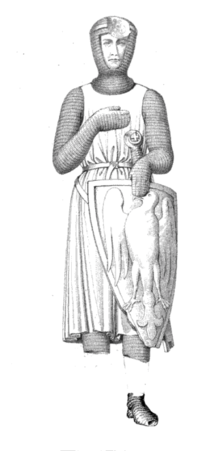Grand-duke-11-5-96


From a programme dated 11 May 1896 for the play The Grand Duke, or, The Statutory Duel, the final Savoy Opera written by librettist W. S. Gilbert and composer Arthur Sullivan, their fourteenth and last opera together. It premiered at the Savoy Theatre on 7 March 1896, and ran for 123 performances. Despite a successful opening night, the production had a relatively short run and was the partnership's only financial failure, The protagonist is a fictitious and penniless Germanic Duke "Rudolph, Grand Duke of Pfennig-Halbpfennig" (Penny-Ha'Penny).
Heraldry
Arms of the Holy Roman Emperor: Or, an eagle displayed with two heads sable with an inescutcheon of arms of the Duchy of Saxony (one of the seven prince-electors): Barry of ten sable and or, over all a crown of rue (rautenkranz/crancelin) in bend vert. Possibly a sardonic reference to the late Prince Consort, Albert, as the House of Saxe-Coburg and Gotha also bore these arms, so they were immediately recognisable by the Victorian general public as representative of "all things Germanic", together with the famous Germanic eagle.
See image of Imperial coat of arms of the Holy Roman Emperor, with the coats of arms of the seven prince-electors: Cologne, Mainz, Trier, Bohemia, Palatinate, Brandenburg, Saxony. Not apparently "the ancient arms of the Savoy" (buildings do not bear coats of arms! Was this a joke to match the comic opera itself?) - the Savoy Palace, the former mediaeval building previously on the site of the Savoy Theatre, was the residence of Peter II, Count of Savoy in the early 1200s, who did not bear these arms (although the shield on his effigy (Église abbatiale d'Hautecombe, Savoie) does show an eagle displayed), later of John of Gaunt, who bore a difference of the royal arms of his father King Edward III of England.Mer information om licensen för bilden finns här. Senaste uppdateringen: Wed, 20 Mar 2024 23:32:55 GMT
